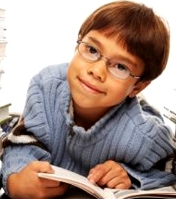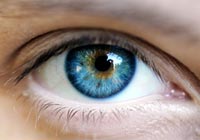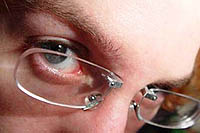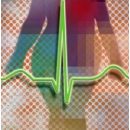Children with amblyopia experience a huge psychological discomfort when they have to wear glasses with clashes. Little patients can help. It turns out that the contact lenses are also shown in ambiance. Of course, there are here and their subtleties.
Content
What is good contact correction of a child
Contact lenses for ambiance
Selection of contact lenses by a doctor
What is good contact correction of a child
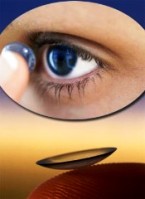 What to do a minor to a child who seems to be required glasses, but classmates laugh above him, call «Occarc»? What can advise a specialist? The doctor was a little embarrassed and answered that if the glasses are required, then parents can explain to the child why they need to be worn. It is a pity that contact lenses were forgotten in this conversation - after all, they could help many children. With his opinion on the use of contact lenses in general, with such a disease as amblyopia, in particular, the doctor of medical sciences Nina Leodorovna Plygunova is divided.
What to do a minor to a child who seems to be required glasses, but classmates laugh above him, call «Occarc»? What can advise a specialist? The doctor was a little embarrassed and answered that if the glasses are required, then parents can explain to the child why they need to be worn. It is a pity that contact lenses were forgotten in this conversation - after all, they could help many children. With his opinion on the use of contact lenses in general, with such a disease as amblyopia, in particular, the doctor of medical sciences Nina Leodorovna Plygunova is divided.
If we talk about the quality of vision correction, then the contact correction can be considered one of the most effective methods. The contact lens, being directly on the eye, creates a single optical system with it, eliminating the limitation of field fields and optical distortions of items when viewed and practically without changing the image. In addition, lenses allow to avoid such well-known problems «Ochkarikov», like fobs of glasses, pressure points on the nose and ears, and do not affect the appearance of the patient. Back in the late 1990s, the only accessible for most Russian doctors method of correction of myopia in children and adolescents were glasses. To the question of what to do if the child is shy of points and because of this refuses to wear them, the doctors diluted with their hands and called upon their parents to be stricter with their children.
Contact lenses are shown to children and adolescents with various disorders of refraction, amblyopia, Aphakia (lack of lens), as well as in cases where the points correction does not give the expected results.
The optimal age of children for the correction of refractive disorders contact lenses is 6-7 years. Contact lenses - the optimal method of correction for children leading the active lifestyle engaged in various sports. Points significantly reduce the peripheral field of view, making it difficult to orientation, so they are not suitable for practicing mobile and team sports, such as sports and rhythmic gymnastics (in these cases it is easy to hardly stay on the nose), hockey (here glasses are also incompatible with protective helmet), football. During games in playgrounds, glasses can dreamed, move and even lead to face injury. As a rule, the main reason for which parents with children are often visited by an ophthalmologist, is a loss, breakage or deformation of glasses. In addition, often soft contact lenses are not only the only possible means of correction of violations of children, but also a means of saving parents of parents.
It is important that wearing glasses, especially with «stronger» Glasses, disadvantageously distinguishes the child among peers, making it vulnerable and generating complexes. And it is his motivation that are determining when choosing contact lenses as a method of view correction method. You should also consider and possibly existing experience of wearing contact lenses from parents. If it is planned that the child will wear contact lenses only during sports workouts and outdoor activities, it is worth choosing that are soft contact lenses, and it is better one-day, because in this case the problem of care lenses is eliminated.
Contact lenses for ambiance
As a rule, the children of school age with amblyopia with difficulty agree to fulfill one of the main recommendations of the doctor - to close the occluder or put the leucoplasty better. The reason for this is the elementary inconvenience and an inesttic appearance. In this case, as an alternative to the clashes, the child can be successfully carried out by penalization using soft contact lenses. Penalization (from FR. Penalite - punishment, fine), artificial deterioration (tumping) of vision is better than a seen eye with the help of correction - one of the effective methods of treating amblyopia. Amblyopia is more common in children with hypermetropy, therefore, as a rule, both eyes need to correlate. The power of the contact lenses, with the help of which it is bold better, the eye should be much larger than its refraction. When using soft contact lenses to carry out a pelenization of a doctor more opportunities than when assigning speaking correction. The difference in the optical power of contact lenses will be easily transferred to the child. The only thing that he should get used to, look worse by a seamy eye. The ability to pry the best eye from under the contact lenses, as children do in glasses, completely excluded.
Selection of contact lenses by a doctor
Featuring contact lenses, the doctor will instruct the children and their parents on the wearing contact lenses and care for them. The doctor must make sure that, if necessary, parents will be able to remove the contact lens from the eye of the child. Doctor need:
- Have full contact with parents. Parents should clearly understand the objective need for contact lenses for their child, they should be aware of all the positive and negative sides of the contact correction.
- Teach parents to wear contact lenses along with the child so that if necessary, they were able to help him wear or remove the contact lens.
- Instruct parents, how to clean and store contact lenses. Simplicity, efficiency and safety of contact lenses, preference should be given to multifunctional solutions.
- To carry out the next change of contact lenses with the obligatory control of visual acuity, each time checking the landing of new contact lenses. Control the correctness of operation, purification and storage by contact lenses and make sure that they do not cause any unwanted manifestations.
 What to do a minor to a child who seems to be required glasses, but classmates laugh above him, call «Occarc»? What can advise a specialist? The doctor was a little embarrassed and answered that if the glasses are required, then parents can explain to the child why they need to be worn. It is a pity that contact lenses were forgotten in this conversation - after all, they could help many children. With his opinion on the use of contact lenses in general, with such a disease as amblyopia, in particular, the doctor of medical sciences Nina Leodorovna Plygunova is divided.
What to do a minor to a child who seems to be required glasses, but classmates laugh above him, call «Occarc»? What can advise a specialist? The doctor was a little embarrassed and answered that if the glasses are required, then parents can explain to the child why they need to be worn. It is a pity that contact lenses were forgotten in this conversation - after all, they could help many children. With his opinion on the use of contact lenses in general, with such a disease as amblyopia, in particular, the doctor of medical sciences Nina Leodorovna Plygunova is divided.



